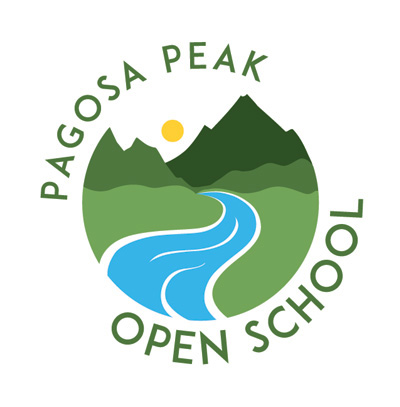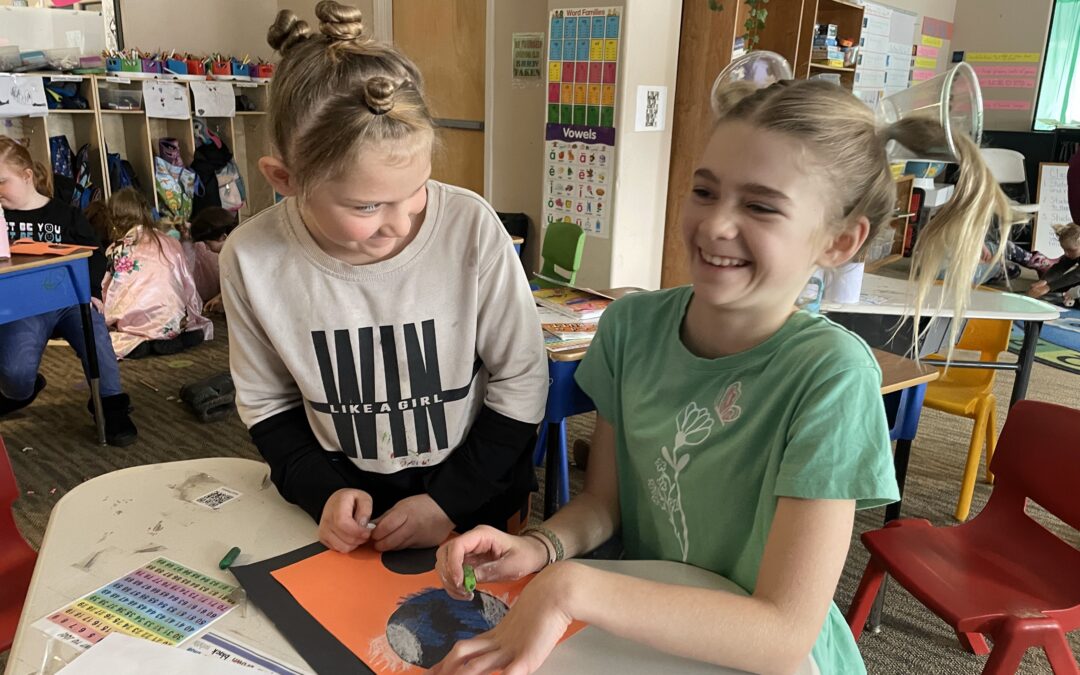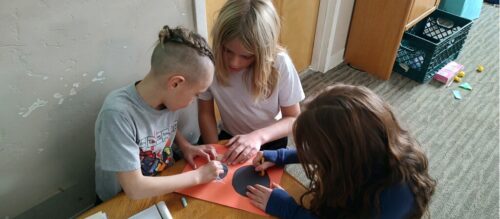Heads hang over hands, voices mingle and cookies break. A fifth-grade boy giggles while listening to Piper, a first-grader instructing him on how to build moon phases out of cookies.
Jonah smiles and follows her directions. His class and hers are both covering outer space concepts through projects at Pagosa Peak Open School (PPOS): Piper and her peers have come to Jonah’s class to teach what they’ve learned and enhance the education of the older students.
“The planning process came together organically,” said PPOS Middle School Advisor Rue Graham. “Both classes had just learned about the lunar phases so the first-graders came in as experts and solidified their learning.”
At PPOS, students engage in project-based learning to address their content standards. The school’s mission includes learning through multi-age collaborations: something these students have become accustomed to and teachers lean into during projects.
PPOS advisors share planning time to discuss project overlaps, natural places for peer-to-peer learning, and age-appropriate topics to cover. In this instance, advisors followed up on another teaching opportunity, creating time and space for the middle school students to visit the first-graders to teach about planets and their relation to Earth. The older students buddied up with the younger ones over pastel crayons, scissors and construction paper; planets and shadows appearing on their papers.
“In this environment, younger students look up to the older ones and are more engaged in the activity,” said PPOS PBL Advisor Kelle Bruno. “We also had siblings between the classes, which gives those students a different perspective of their brother or sister. They get to see each other in their element in a way that is unique to our school. I also observed that the older students felt empowered by teaching the younger students.”
These projects include the essential elements of gold star PBL. While collaboration across grade levels is not an identified part of a project, these experiences have enhanced reflection, authenticity, critical thinking and sustained inquiry. PPOS PBL advisors ensure high quality projects through the use of state standards, a schoolwide PBL teaching rubric, voice and choice from students, and community partners. When they work together, they celebrate, enhance and revise each other’s work to a higher standard. To culminate this project, first-graders shared celestial poems and artwork, the local Stargazers Club did a community Space Race presentation, and the middle-schoolers shared a scale model of the solar system with planet facts – strung up in the school’s atrium. In addition to enhancing things like celebrations of learning, collaborations like these build a positive school culture through these mixed-age interactions among students.
PPOS schedules large blocks of time for projects, while also giving advisors autonomy around schedule changes to accommodate project
“I got to partner with Hazel, which I loved,” said fifth-grader Quinn about her first-grade partner for this project. “She makes me laugh and is a really good artist. She’s my friend. I like being able to work with first grade. It helps me feel connected to their work, and excited about what’s happening in other classes.” The benefits of these relationships spill over into other aspects of the school day. Students call each other by name, help each other on the playground, and sit with each other in the cafeteria during breakfast. The school becomes a whole community instead of a series of smaller, classroom-only communities.
“As a teacher, I enjoy watching the students work together. There is a strong sense of engagement,” Bruno says.
Students at PPOS do not walk through a project with a focus on state standards alone. With each project comes an opportunity to grow soft skills, contributing to a more peaceful world and well-rounded education.
“We saw opportunities for learning outside the content standards that aligned with character traits we encourage at PPOS,” Graham says. “The 5/6th graders felt pride and accomplishment in creating a lesson plan complete with learning targets, activities, and assessment to bring to the first-graders. They were very nervous to present and took their work seriously. It really “leveled- up” the professionalism as opposed to same age peer sharing of knowledge, while providing an opportunity for empathy building. Students identified teaching young children as ‘difficult’, building a greater understanding of the staff work they see each day.”
These social emotional skills are highlighted through the school’s project work, as well as intentional, direct weekly lessons from the counselor and through circles classes hold every morning and afternoon. The time investment is built into the school schedule, prioritized in the school budget, and seen through the collaborative work of the students.
“Multi-age collaborations afford students to mentor and be mentored,” Graham said. “Learning from child peers makes the learning more meaningful and novel, and engages students in a more complex experience to solidify character development.”




